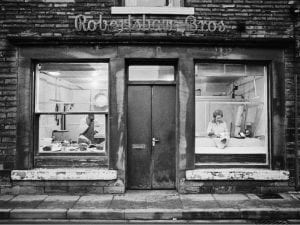In Bologna, at MAST Foundation, Mari Bastashevski (Russia), Sara Cwynar (Canada), Sohei Nishino (Japan) and Cristobal Olivares (Chile), shed light on geographic and human worlds that reflect the rapid transformations taking place in today’s economy. Until 1 May, the foundation presents pieces from the GD4PhotoArt competition finalists: a Photographic Grant themed around Industry and Work. The winner of which has recently been announced as Sohei Nishino, whose imagination centres on accidental documentation and memory.
A: Congratulations on winning this year’s grant with ex aequo. How will this prize enhance your practices?
SN: Regarding the collage work, I normally show a series of works as one piece, in order to represent my experience focused on one place. But this time I divided it into eight different panels. This work – which is devoted to river Po – is about one water course which starts from one drip of water in Mt Alpes to finally reach Adriatic sea and, on its way, it goes through many villages, mountains, cities, deltas, factories, and agricultural areas. I wanted to express – along the 650km journey – how the river goes through so many locations and how each section reveals a new emotional landscape.
This time I’m also showing snapshots, something that’s incredibly new for me. These works are almost like visual travelogues about the journey in itself and about my experience, they are stories of people I met, described without text. The work’s timeline has to be related to industries and territory too, due to the theme of MAST competition. So, by showing both those issues, in different ways, I created micro and macro views of expression. Now I think, after this processing, I will include more documentary approaches than a traditional or usual way of managing photography.
A: Does the activity of walking represent a kind of visual, inner meditation for your photography?
SN: Walking is a deep process for me; it represents a sort of spiritual healing. The time I spend in a journey, I use to compose one last, final, flat picture; it expresses how I live my life. Indeed, I assemble almost all of the pictures instead of selecting them. This idea reflects an analogue process which is also very important in order to bring back my memories and compile my physical feelings – sensations deeply connected to my form of mind.
A: You once stated that “as soon as I arrive in a new city, I go to the highest point to command a view of the city.” Is this true of when you arrived in Bologna?
SN: After coming back back from photographing, I stayed in Bologna for few days but I was too tired to go outside. Normally I climb up the highest point of the city to shoot images, because this helps me a lot for understanding where I am exactly located. By looking from the highest point, I can draw my own map, impressing it directly on my mind. So, in case I get lost, I can recall a visual map from this point. However, at the same time, I can say that getting lost is very important; by encountering unexpected things I find what I’m actually looking for.
A: Have you ever got really lost in a city, and what has this meant for creating a prismatic and complex experience?
SN: Yes I did, in fact, getting lost is very important. Walking for a long period instils inside me with a kind of meditative feeling and once I find myself in such condition, the brain starts shutting down the noise, and the city’s information suddenly appears in full form. Then I become more sensitive rather than logical. This helps me to encounter the more essential elements of the city.
A: What did River Po, the subject for this series, teach you in terms of its changing landscape?
SN: For this particular series I was changing my location day by day; usually I stay in one place. The speed of my movement was almost the same as the flow: I wanted to feel and see how water changes from the mountain to the sea, allowing me to comprehend the nature of water more deeply.
Italian history has included several disasters due to many floods, and so it has always been dangerous living alongside the river. However, people do gather there; the river plays a very important role in our society, both locally and globally. We have learned that the river is the origin of culture and is a body of water that has nourished societies.
On the other hand, because of all of those reasons, the scenarios that take place at the riverbed have been shaped by humans. For children, it might manifest in a pleasant memory, a place where they learn, and a place where their personality will take form. Once again, the water is a spark for learning and innovation; playing near the river means that they learn the law of nature – its systems and mechanisms. Humanity creates a loop with the water through circulation, renewal and rebirth.
A: What does the use of black and white mean for your collages?
SN: I wanted to focus on the form of the river and its different rhythms, enhancing how one water course starts and how it ends. Water doesn’t have a specific colour – it’s transparent and creates several shades when it reflects various environments. So, in order to make it more neutral and objective, I expressed this travelogue in monochrome.
Ginevra Bria
For more information about the MAST Photographic Grant, click here.
Credits:
1. Sohei Nishino – Il Po, 2017, Casa sul fiume, Luzzara © Sohei Nishino.





